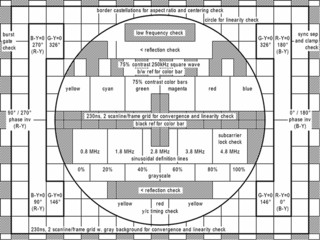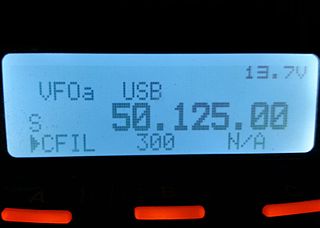Related Research Articles
The ISM radio bands are portions of the radio spectrum reserved internationally for industrial, scientific, and medical (ISM) purposes, excluding applications in telecommunications. Examples of applications for the use of radio frequency (RF) energy in these bands include RF heating, microwave ovens, and medical diathermy machines. The powerful emissions of these devices can create electromagnetic interference and disrupt radio communication using the same frequency, so these devices are limited to certain bands of frequencies. In general, communications equipment operating in ISM bands must tolerate any interference generated by ISM applications, and users have no regulatory protection from ISM device operation in these bands.
Citizens band radio is a system of short-distance radio communications between individuals on a selection of 40 channels within the 27-MHz band. In the United Kingdom, CB radio was first legally introduced in 1981, but had been used illegally for some years prior to that.

Amateur television (ATV) is the transmission of broadcast quality video and audio over the wide range of frequencies of radio waves allocated for radio amateur (Ham) use. ATV is used for non-commercial experimentation, pleasure, and public service events. Ham TV stations were on the air in many cities before commercial television stations came on the air. Various transmission standards are used, these include the broadcast transmission standards of NTSC in North America and Japan, and PAL or SECAM elsewhere, utilizing the full refresh rates of those standards. ATV includes the study of building of such transmitters and receivers, and the study of radio propagation of signals travelling between transmitting and receiving stations.
The L band is the Institute of Electrical and Electronics Engineers (IEEE) designation for the range of frequencies in the radio spectrum from 1 to 2 gigahertz (GHz). This is at the top end of the ultra high frequency (UHF) band, at the lower end of the microwave range.
The X band is the designation for a band of frequencies in the microwave radio region of the electromagnetic spectrum. In some cases, such as in communication engineering, the frequency range of the X band is rather indefinitely set at approximately 7.0–11.2 GHz. In radar engineering, the frequency range is specified by the Institute of Electrical and Electronics Engineers (IEEE) as 8.0–12.0 GHz. The X band is used for radar, satellite communication, and wireless computer networks.
The 70-centimeter or 440 MHz band is a portion of the UHF radio spectrum internationally allocated to amateur radio and amateur satellite use. The ITU amateur radio allocation is from 430 to 440 MHz; however, some countries, such as the United States, allocate hams 420 to 450 MHz. Depending on the country the band is shared with other radio services.

PMR446 is a licence-exempt service in the UHF radio frequency band and is available for business and personal use in most countries throughout the European Union.
The 33-centimeter or 900 MHz band is a portion of the UHF radio spectrum internationally allocated to amateur radio on a secondary basis. It ranges from 902 to 928 MHz and is unique to ITU Region 2 (Americas). It is primarily used for very local communications as opposed to bands lower in frequency. However, very high antennas with high gain have shown 33 centimeters can provide good long-range communications almost equal to systems on lower frequencies such as the 70 centimeter band. The band is also used by industrial, scientific, and medical (ISM) equipment, as well as low-powered unlicensed devices. Amateur stations must accept harmful interference caused by ISM users but may receive protection from unlicensed devices.

The 6-meter band is the lowest portion of the very high frequency (VHF) radio spectrum internationally allocated to amateur radio use. The term refers to the average signal wavelength of 6 meters.
Shortwave bands are frequency allocations for use within the shortwave radio spectrum. Radio waves in these frequency ranges can be used for very long distance (transcontinental) communication because they can reflect off layers of charged particles in the ionosphere and return to Earth beyond the horizon, a mechanism called skywave or “skip” propagation. They are allocated by the ITU for radio services such as maritime communications, international shortwave broadcasting and worldwide amateur radio. The bands are conventionally named by their wavelength in metres, for example the ‘20 meter band’. Radio propagation and possible communication distances vary depending on the time of day, the season and the level of solar activity.

The 60-meter band or 5 MHz band is a relatively new amateur radio allocation, first introduced in 2002, that was originally only available in a few countries, such as the United States, United Kingdom, Norway, Finland, Denmark, Ireland and Iceland. Over a number of years however, an increasing proportion of countries' telecommunications administrations – together with their government and military users – have permitted Amateur Radio operation in the 5 MHz area on a short or longer-term basis, ranging from discrete channels to a frequency band allocation.
The 4-metre (70 MHz) band is an amateur radio band within the lower part of the very high frequency (VHF) band.
The 23 centimeter, 1200 MHz or 1.2 GHz band is a portion of the UHF (microwave) radio spectrum internationally allocated to amateur radio and amateur satellite use on a secondary basis. The amateur radio band is between 1240 MHz and 1300 MHz. The amateur satellite band is between 1260 MHz and 1270 MHz, and its use by satellite operations is only for up-links on a non-interference basis to other radio users. The allocations are the same in all three ITU regions.

Citizens band radio is a system of short-distance radio communications between individuals on a selection of channels within the 27-MHz band. In India, this frequency band extends from 26.957 MHz to 27.283 MHz. There are several different channel plans in use. Citizens band is distinct from the Family Radio Service, GMRS, Multi-Use Radio Service and amateur radio (Ham). In many countries CB operation does not require a license, and it may be used for business or personal communications. Like many other two-way radio services, any citizens band channel is shared by many users. Only one station may transmit in a channel at a time; other stations must listen and wait for the shared channel to be available. Also, the system works in half-duplex mode, which means we may transmit and receive information, but not both at the same time.
The 9-centimeter band is a portion of the SHF (microwave) radio spectrum internationally allocated to amateur radio and amateur satellite use. The amateur radio band, in ITU regions 1 and 2, is between 3.300 GHz and 3.500 GHz, and it is available only on a secondary basis. The amateur satellite band is between 3.400 GHz and 3.410 GHz, and it is only available in ITU Regions 1 and 2, on a non-interference basis to other users. In Germany and Israel, the band 3.400 - 3.475 GHz is also allocated to the amateur service on a secondary basis.
A short-range device (SRD), described by ECC Recommendation 70-03, is a radio-frequency transmitter device used in telecommunication that has little capability of causing harmful interference to other radio equipment.
The 800 MHz frequency band is a portion of the electromagnetic spectrum, or frequency band, that encompasses 790–862 MHz.
Call signs in United Kingdom include a three letter country code, and a series of letters and numbers.
Wireless microphones may operate over various frequencies, licensed or unlicensed depending upon the country.
References
- ↑ CEPT/ERC REC 70-03 Archived 2013-08-05 at the Wayback Machine (22 August 2011)
- ↑ "ECC Decision (15) 05" (PDF). CEPT Electronic Communications Committee. Archived from the original (PDF) on 2017-08-19. Retrieved 2017-12-06.
- ↑ "The Consumer Electronics Hall of Fame: Motorola T250 Talkabout Walkie-Talkies". IEEE Spectrum: Technology, Engineering, and Science News. Retrieved 2020-05-09.
- ↑ "IR 2030 - UK Interface Requirements 2030 - Licence Exempt Short Range Devices" (PDF). Ofcom. July 2017. Archived (PDF) from the original on 2022-10-09. Retrieved 2017-12-06.
- ↑ "United Kingdom Frequency Allocation Table 2013" (PDF). Ofcom. Archived (PDF) from the original on 2022-10-09. Retrieved 2014-01-07.
- ↑ "Interference between Short Range Devices and Amateur Repeaters" (PDF). Ofcom. Archived (PDF) from the original on 2022-10-09. Retrieved 2014-01-07.
- ↑ "Paper on SRD Mitigation Techniques" (PDF). R.S.G.B. Emerging Technology Co-ordination Committee. Archived (PDF) from the original on 2022-10-09. Retrieved 2014-01-07.
- ↑ "Technical interfaces regulations". OFCOM (Swiss Federal Office of Communications). Retrieved 2020-10-03.
- ↑ "Radiocommunications in Switzerland" (PDF). Bundesamt für Kommunikation. Archived (PDF) from the original on 2022-10-09. Retrieved 2020-10-03.
- ↑ "Resolución de 12 de marzo de 2021, de la Secretaría de Estado de Telecomunicaciones e Infraestructuras Digitales, por la que se publican los requisitos técnicos actualizados de las interfaces radioeléctricas reglamentadas IR-264, IR-265 e IR-266 relativas a equipos de radio para dispositivos de corto alcance (SRD) no específicos, en la banda de frecuencias ICM de 433 MHz". Secretariat of State for Telecommunications and Digital Infrastructure of the Government of Spain. Retrieved 2022-10-16.
- ↑ "ERC recommendation relating to the use of short range devices (SRD), Annex 1, Note 11". CEPT. Retrieved 2022-10-17.
- ↑ RC-Network.de Fernsteuerfrequenzen für den Modellbau - Deutschland (Frequency bands for RC modeling - Germany) - "Am 31.12.2008 endet die Betriebserlaubnis für Fernsteuerungen im Frequenzbereich 433 MHz!" Archived 2016-03-23 at the Wayback Machine (As of 12/31/2008, RC use of the 433 MHz bands ends in Germany!)
- ↑ "United Kingdom Radio Control Council: International Frequencies - Germany". UKRCC. UKRCC. Archived from the original on March 4, 2016. Retrieved July 13, 2013.
- ↑ "Guidelines for Amateur Radio Services in Malaysia 2nd Edition" (PDF). Archived (PDF) from the original on 2022-10-09. Retrieved 11 Feb 2018.
- ↑ "MCMC MTSFB TC T007:2014 - Specification for Short Range Devices" (PDF). Archived (PDF) from the original on 2022-10-09. Retrieved 11 Feb 2018.